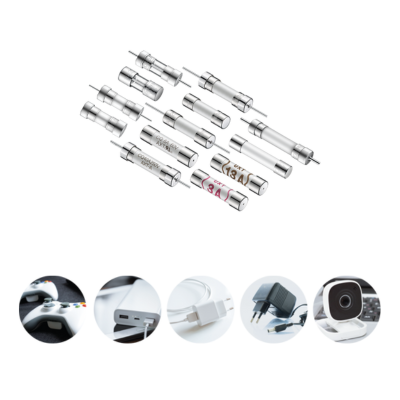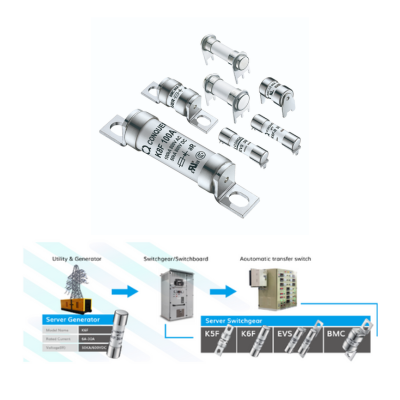
Protecting Circuits Across Industries - Conquer Fuses
What is a Fuse?
It is a safety component in electrical systems, protecting circuits from overload currents that can cause damage, overheating, and potential fires. The fuse works by interrupting the electrical current if it gets too high, preventing any further harm to the other connected components and electrical applications.
How Does a Fuse Work?
A common type of fuse features a glass tube with a metal strip or wire inside, designed to handle a specific amount of current. Under normal conditions, current flows through this wire.
However, if the current exceeds the fuse's capacity, the wire overheats and melts. It interrupts the flow of electricity, breaking the circuit and stopping the flow of potentially hazardous voltage.
Key Factors to Consider When Choosing a Fuse:
A fuse must be able to carry the normal current load of a circuit, without abnormal open circuit events. In case of an overload event, it needs to stop the excess current, limit energy flow, and withstand any arcing between terminals. When choosing a fuse, consider the following factors:
- Normal operating current (the current rating of a fuse is typically derated 25% for operation at 25°C to avoid nuisance blowing. For example, a fuse with a 10 A current rating is not usually recommended for operation at more than 7.5 A after considering 25% derating).
- Overload current and melting time of the fuse.
- Application voltage (AC or DC voltage).
- Inrush currents, surge currents, pulses, and/or start-up currents.
- Ambient temperature.
- Safety certification (i.e. UL, CSA, etc.).
- Other considerations: Shape, dimension, installation (surface mount or through hole…)
Different Types of Fuses:
Fuses come in various voltage capacities to suit different applications, industrial, manufacturing, and electronic environments.
The duration it takes for a fuse to blow is referred to as its "speed." There are three main types of fuse speeds:
- Ultra Rapid Fuse / Very Fast-Acting Fuses: Commonly utilised in sensitive circuitry and transistors, offering protection against short circuits by reacting at near-instantaneous speed.
- Quick-Acting / Fast-Acting Fuses: Designed to protect fewer sensitive components, these fuses are also used to safeguard cabling from melting and are used in circuits without transient inrush currents.
- Time Lag Fuse / Slow-Acting Fuses: This type of fuse is suitable for circuits with transient surges or power-on inrush currents, which include motors, transformers, incandescent lamps, and capacitive loads.
At Active Components, we are proud to partner with Conquer Fuses, offering a diverse range of high-quality fuses tailored to various needs.
Surface Mount Fuses – LTCC Chip Fuses
The LTCC structure includes a fuse element that offers superb heat resistance and an extremely high interrupting rating, allowing it to withstand a high degree of inrush current. It has a precise melting time, providing optimal protection for sensitive electronic components. Additionally, the reflow soldering process allows them to be directly mounted on printed circuit boards. This compatibility with various circuit designs makes it an ideal choice for all kinds of consumer electronics applications.
Applications
- Thermostat.
- Temperature Sensors.
- Humidity Sensors.

.png)
Surface Mount Fuse (SMD)
Suitable for use in both AC and DC circuits; the SMD fuse is available in a wide range of operating temperatures and current/voltage ratings. The internal fuse elements connect to the external fiberglass or ceramic body, creating a durable structure that increases reliability, while surface mount technology allows for use on small printed circuit boards.
Applications
- Smart Doorbell.
- Chargers.
- Medical Equipment.
- Cooling Fan System.
- Battery Management System.

.png)
Subminiature Fuse
The subminiature fuse offers the best solution to overcurrent protection for space-limited printed circuit boards. The UL94 V-0 rated flame retardant plastic body can withstand harsh external conditions, while High-Frequency soldering technology increases fuse stability and reliability. Available in a wide range of current ratings, the subminiature fuses are ideal for consumer electronic applications, including LED lighting systems, chargers, and power supplies.
Applications
- Smart Outlet.
- Charger.
- Lighting systems.
- Consumer Electronics.
- Battery Chargers.

-(1).png)
Axial Lead & Cartridge Fuse
Conquer’s highly versatile axial lead and cartridge fuse offers cost-efficient and reliable overcurrent protection solutions across industries—from consumer electronics and telecommunications to home appliances and lighting. Fuse specifications vary in terms of current/voltage rating, breaking capacity, l2t value, time-current curve, and safety certifications, ensuring total circuit protection across industries.
Applications
- Power Supplies.
- Home Appliances.


Power Fuse
With an extremely short trip time, a low l2t value, and a voltage rating reaching up to 1000 V, Conquer's power fuses offer optimal protection against overload and short-circuit events in high-power AC and DC circuits. Each fuse is composed of an ultra-strong ceramic tube filled with high-purity silica sand, increasing reliability and enhancing electric arc quenching capabilities. Ideal for use in applications with sensitive internal components, including PV systems and electric vehicle battery chargers.
Applications:
- EV Charging Stations.
- EV Car Appliances.
- Power Converters.
- Power Supply.


We are here to help - Contact us today!

